Check back here for S&T coverage of May 20th's solar eclipse, reader reports, and featured pictures from our photo gallery!
| Update, May 21, 2012: We've posted several new reader reports, plus a breath-taking movie of the eclipse's shadow taken from NASA's International Space Station. |
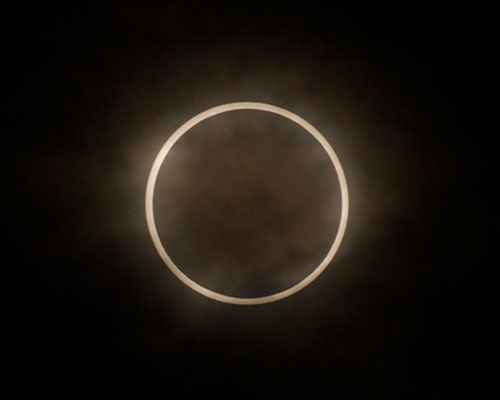
Chris Bosshard shot Sunday's annular bull's eye in Tokyo as clouds were beginning to roll in. This shot was Sunday's Editor's Choice in our Photo Gallery.
Chris Bosshard
S&T editors Dennis di Cicco, Camille Carlisle, and Kelly Beatty had front-row seats to the solar eclipse that swept across western and central U.S. on Sunday, May 20th.
And we want to hear from you too! Submit reader reports as comments below and submit your photos to our Photo Gallery. Check back as we update this page with post-eclipse coverage.
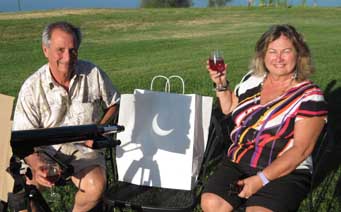
Mike and Diane Naggiar, the friendly owners of Naggiar Vineyards, offer a toast during an impromptu gathering of family, staff, and friends during the May 20, 2012, annular eclipse. Between them is an image of the eclipsed Sun projected by Diane's 60-mm refractor.
J. Kelly Beatty
A Hilltop in the Sun
by Kelly Beatty
This was my sixth annular eclipse, and I observed it (along with my wife, Cheryl, and other family members) from Naggiar Vineyards, located in Grass Valley and just a couple of thousand feet inside the path's southern limit.
The day was beautifully clear and a bit warm. We arrived at the winery about an hour before first contact and, after introducing ourselves to the owners, prepared for the coming spectacle with an 80-mm f/5 refractor for viewing and a 4½-inch f/4 reflector for photography. The winery closed at 5 p.m., a little before first contact, but as the Moon's bite deepened we gradually assembled a gaggle of about 30 eager onlookers.
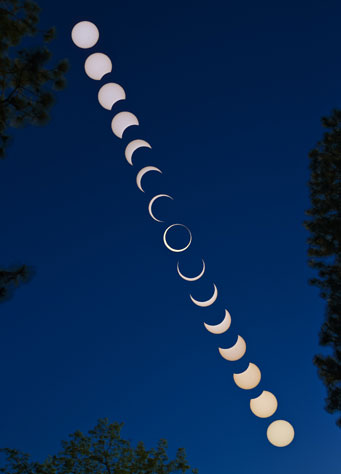
Tony Halllas had the good luck of living just inside the "ring boundary," so he stayed put for the eclipse and captured this beautiful sequence.
Tony Hallas
The eclipse had been under way less than 30 minutes when I first noticed the change in the surrounding daylight — sooner than I expected but unmistakable: a perceptible dimming, crisp shadows, and that unique silvery quality that I'd seen before. As we neared second contact, the temperature dropped perceptibly from the low 80s (Fahrenheit).
We were just barely inside the southern limit, so I knew the complete annulus would be fleeting telescopically and unobservable visually. Second and third contact were just a half second apart. Even viewing through my telescope, I'm still not sure that I'd see a complete ring.
But the onlookers didn't care. We'd brought enough viewing glasses for everyone, along with two pair of properly filtered binoculars and the telescopes. Many of them had somehow not known the eclipse was going to occur, and they buzzed with excitement.
We hit the road long before fourth contact — happy that we'd transformed a lazy Sunday afternoon into such a festive occasion.
Fogbound on the California Coast
by Camille Carlisle
Like all things Humboldt County, the annular eclipse here was cloudy. But even flanked by thick, cottony white, the event was spectacular. I'd estimate at least 400 people made the trek up above the fog bank into the hills, to the (somewhat precariously perched) Kneeland Airport, a small stretch of blacktop surrounded by rolling slopes of redwood and Douglas fir.
At mid-eclipse, screams and trills erupted from the crowd. My uncle and I shoved out heads together to share one pair of eclipse glasses, each of us snagging one lens to gape at the great glowing O. Barely visible through the glasses, the clouds nearest the Sun reflected gleaming wisps of light.
Much to our disappointment, combining eclipse glasses and a digital camera just didn't do the trick. (Yeah, I know, you experienced photographers are laughing at me.) But four amateur astronomers from Bellevue, Washington, came to my rescue: one of them had steady enough hands to snap a shot of the partial with my iPhone through his 6-inch Dobsonian.
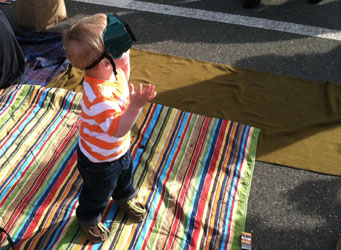
A toddler watches the eclipse from Humboldt County with a pair of protective welder's goggles.
S&T: Camille Carlisle
There was plenty to see, even for those who came too late to snag eclipse glasses. (The Astronomers of Humboldt brought 100 of them but ran out in 15 minutes — even though they only gave out one per family). Club president Russ Owsley helped me and my uncle rig a cheap department-store telescope up as a projector with some cardboard. We didn't have anything to steady it with besides our hands, but it worked surprisingly well. Other observers shared everything from Coronado solar telescopes to a cardboard box catching reflections from an old telescope mirror. There were even toddlers staggering around with welder's goggles on.
Eclipse Over the Jansky Large Array
by Dennis di Cicco
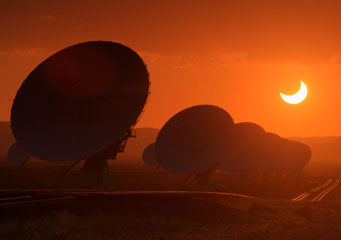
Johnny Horne captured the partial eclipse over the dramatic backdrop provided by the Jansky Very Large Array — more than making up for the clouds that blocked much of the annular phase.
S&T: Dennis di Cicco
S&T contributing editor Johnny Horne, former S&T assistant editor John Briggs, and I were among about 100 people gathered to watch the annular eclipse at the roadside along the southeast arm of the Jansky Very Large Array (radio telescope) in New Mexico. The group included 15 amateurs from the San Antonio League of Sidewalk Astronomers (SALSA) who made the 12-hour drive from Texas for the event. Despite overall clear skies, a patch of slow-moving clouds hampered the view during the annular phase, leaving only brief moments when the full ring of sunlight was visible. As a consolation, the clouds and low-altitude Sun provided a dramatic view set against the radio telescope dishes, which continued to observe the Sun as the eclipse progressed. Judging from the good-natured joking that followed the annular phase, it seemed pretty clear that everyone enjoyed the event.

"Success in the high desert!" After two weeks of careful planning, Imelda Joson and Edwin Aguirre took this beautiful sequence of Sunday's annular eclipse.
Imelda Joson and Edwin Aguirre
Paul Maley of the NASA Johnson Space Center Astronomical Society writes in about his experience observing the annular eclipse from Tokyo:
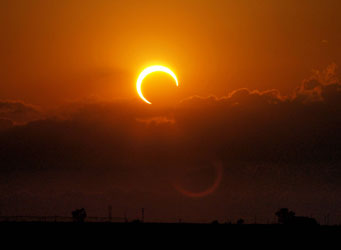
Matt Ventimiglia (Griffith Observatory) sent S&T this gorgeous shot from West Texas near Meadow.
Matt Ventimiglia
"I was able to amazingly photograph the annulus thru cloud during a brief gap just at the perfect time of annularity. The forecast had looked dreadful and three layers of cloud moved randomly covering up to 95% of the sky. The sun was essentially not visible from first contact until one minute after second contact. The few Japanese who had gathered to watch with me behind the Narita Hilton were so amazed they began screaming at the site of an annular eclipse. I have never seen this before in the 39 formal expeditions to solar eclipses I have made in the past."
Ken Geiger sent us this report from Colorado:
"I’ve been a subscriber since 1961. It was a BEAUTIFUL eclipse (my first Annular eclipse) and a beautiful observing site – there was not a single cloud in the sky! From our location, the sun began to set behind a ridgeline just after third contact."
A report from Luca Quaglia, from Gunma Prefecture, Japan:
"I observed the annular solar eclipse from just within 1.5km
of the (nominal) northern limit near Minakami in Gunma
Prefecture, north west of Tokyo, at the foothills of the
Japanese Alps. The sky was virtually blue and clear, with
only a few scattered, isolated and thin high altitude cirrus
clouds. Some haze and thin clouds towards the east dissipated
within the first 20 minutes of partiality.
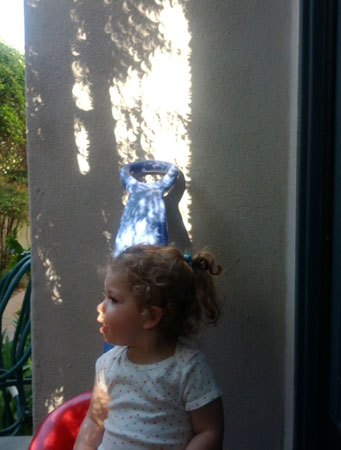
Astronomer and eclipse-chaser Jay Pasachoff's granddaughter sees her first eclipse at 20 months old. The shadows behind her take on the crescent shape of the partial eclipse.
Ian Kezsbom and Deborah Pasachoff
"The light slightly dimmed around the time of the maximum and all was even quieter than before in this peaceful rural countryside valley dotted with thermal baths (onsen).
A couple of minutes after the maximum, frogs started to croak just for around five minutes and bird life got excited.
"Annularity was fleeting but mesmerizing beautiful! Near the maximum, the two horns of photosphere rotated quite rapidly and got closer until suddenly for no more than 10 seconds (to me, for what it seemed just like a heart beat!) they were connected by an uninterrupted very thin filament of fuzzy Baily's beads. To the unaided naked eye, the eclipse had got fleetingly but unmistakably annular. Through the black
polymer eclipse glasses, the continuous thin filament looked like a series of shades of orange and not yellowish like the rest of the very skewed ring of light. And then annularity was over.
"I had planned to observe from near the center line in Tokyo, but on a whim I changed idea on Sunday and ended up, a bit by coincidence, literally on the norther limit. The onset was more or less 200m outside the nominal northern limit. On eclipse morning I just walked south of it. I had never observed from the limits but I found it an incredibly rewarding experience, full of very subtle dynamical effects."
Glenn Schneider took it easy outside cloud-free Winslow, AZ:
""Taking It Easy" in Cloud-Free Winslow, Arizona:
"[This solar eclipse] was the first for me I can recall that I kept to a self-made promise to 'just watch.' Only eyepieces in telescopes, no cameras! And, post-facto glad for that decision. From just a couple of km inside the southern limit, at the northern periphery of the town of Winslow, Arizona, the not-quite-touching needle-thin cusps of the grazing annulus with a dynamically changing, small, arc-like thread of a bead-punctuated ribbon co-joining and rotating around the limb of the Sun was quite fascinating to 'just watch'."
NASA shared a different angle on the solar eclipse — their view from the International Space Station. You won't see the moon, but you'll see its shadow on the Earth. The solar space probe Hinode provided a view of the eclipse itself.
For more reports, check out the comments section below (and submit your own!), and also check out our Photo Gallery for some gorgeous eclipse shots.
 5
5









Comments
NTS
May 21, 2012 at 1:51 am
Tried to observe the eclipse from Honolulu, which was near the southern edge of the partial eclipse (10% of sun covered at max). Unfortunately for most of the eclipse the sun at my location was obscured by thin clouds. But luck was with me, at just the time of maximum coverage the sun passed across a cloud-free area so I was able to project an image of the sun. And my wife saw it too! Made my day.
You must be logged in to post a comment.
nakedgun
May 21, 2012 at 3:02 am
Mid to upper 90's here in Southern California (33N) at first contact, so I thought none of my neighbors would be brave enough to come out, but they did! Noticeably darker (and cooler!) at maximum, near 80% obscuration. About 15 of us enjoying the view. Sun went down over western mountains before event ended, which was quite a sight in its own right.
You must be logged in to post a comment.
Bruce
May 21, 2012 at 6:27 am
I watched the event from a lakeside home in Mathis Texas with three other families while enjoying a qreat barbeque diner. One of my freinds there is a welder and he provided us all with welding hood filter material so all could observe safely. The partially eciplsed sun thruogh thin streaks of clouds looked especially dramatic about 30 min. prior to our sundown. After that the local event was prematurely ended as the bottom, eclipsed part of the Sun set behind a thick cloudbank. Then the observing moved inside and we watched the online ustream event provided by amateur astronomer Scotty Degenhart in Nevada. 2nd and 3rd contacts were great. I wish to thank Mr. Degenhart for your efforts, many more people benefited from your upload than the logged on number indicated, as our party of 13 shows. It's sad that so many missed out on this! So many professional efforts were clouded out, unfortunately. Anyway, we all got a good warm up for June's Venus transit. Clear skies then, I hope.
You must be logged in to post a comment.
John Horvath
May 21, 2012 at 8:38 am
I watched eclipse with a tree camera. Tree leaves make pinholes. The viewing screen is my car. Years ago I watched a partial eclipse in New York under a maple tree. Thousands of small eclipse images on the ground. Yesterday I saw nothing on the ground. Looked up. The tree made eclipse images are on the car. The New York images were smaller because the ground was closer to the leaf made pinholes. The eclipse in New York was overhead. Yesterday the eclipse was near the horizon. The screen needs to be perpendicular to the image. So the tree made images projected on the side of the car.
You must be logged in to post a comment.
jaime
May 21, 2012 at 12:06 pm
congratulations & thanks x the fhotos, here captured & published. I had hard time with internet web. pages, here recommended, plus the bad weather at Japan, Co.Usa., and west clouds hee at Chih. Chih.Invited to see my past notes at http://www.Yahushah.net/astronomia.html
You must be logged in to post a comment.
You must be logged in to post a comment.